Voice-controlled fishing reels transform disabled lives by enabling independent participation in a beloved outdoor activity. You’ll find these innovative devices allow hands-free operation, letting anglers with limited mobility adjust drag or reel speed through simple vocal commands. They’ve empowered people like Hunter Baughman, a double amputee who competes professionally using adaptive technology. Beyond physical benefits, this technology fosters social inclusion, restores self-esteem, and creates meaningful connections among those facing similar challenges.
The Rise of Voice-Controlled Fishing Technology
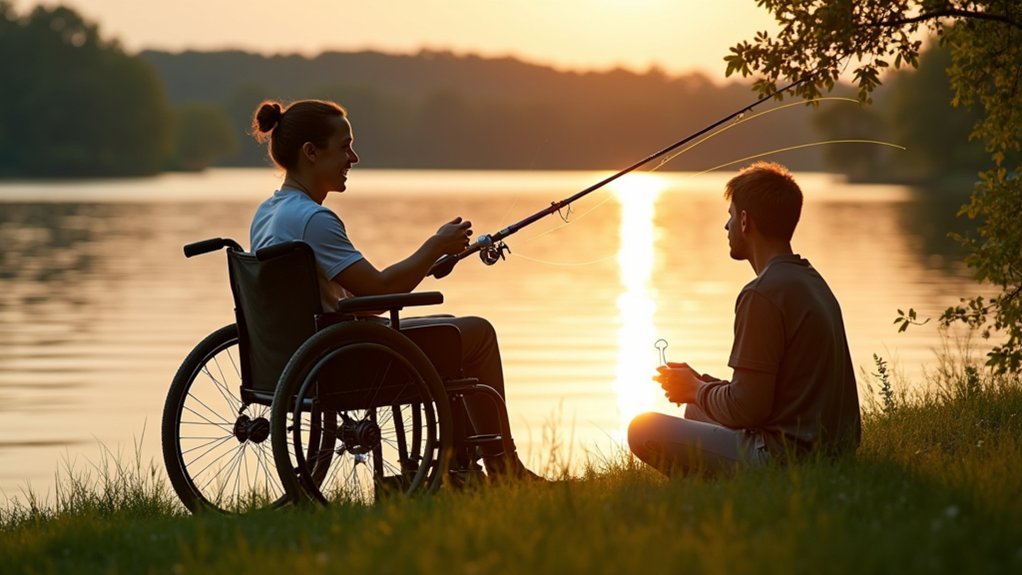
While cutting-edge smart fishing reels currently focus on motion sensing and digital cast control, true voice-controlled fishing technology remains largely conceptual.
You won’t find prominent voice-controlled reels on today’s market, but the groundwork is being laid through innovations like KastKing’s iReel with its motion capture capabilities.
Smart reels already provide detailed performance metrics and wireless connectivity that could easily adapt to voice command systems. KastKing has specifically designed its iReel with Bluetooth-equipped intelligence that could potentially interface with voice command technology in future iterations.
Modern smart reels track every cast while their connectivity creates the perfect foundation for future voice command fishing.
The technology is progressing toward a future where you might simply say “cast” or “reel in” rather than struggling with manual controls.
This technological integration isn’t just about convenience—it represents the potential bridge connecting disabled anglers with greater independence on the water, despite current limitations in outdoor voice recognition and waterproofing challenges.
Breaking Down Barriers: How Voice Commands Enable Independent Fishing
You’ll experience newfound freedom at the lake when using voice-controlled fishing reels that operate without manual handling.
These innovative systems let you fight fish hands-free, using just vocal commands to adjust drag or reel speed during the excitement of a catch.
Your independence on the water increases dramatically as voice technology removes physical barriers that once limited fishing participation for many enthusiasts. Ken’s Power Caster specifically uses sip-and-puff technology for individuals with severe paralysis who cannot operate traditional buttons.
Freedom at the Lake
For many anglers with physical disabilities, a day at the lake often meant dependence on others—until now.
Voice-controlled fishing reels are transforming this experience, offering you unprecedented independence and freedom.
Imagine casting your line and controlling your reel with simple voice commands. No more struggling with buttons or switches when your mobility is limited. These systems integrate seamlessly with microprocessors that monitor and adjust settings automatically based on your verbal instructions. The technology applies precise braking to prevent backlashes and enhance casting distance, making fishing more accessible for those with limited dexterity.
You’ll find a new sense of self-reliance as you fish alongside friends and family without requiring their assistance. The technology adapts to various disabilities, ensuring you can participate fully in the sport you love.
This isn’t just about catching fish—it’s about reclaiming your autonomy at the lake and experiencing the joy of independent outdoor recreation.
Hands-Free Fish Fighting
When the real magic of voice-controlled fishing reels becomes apparent, it’s during the most exhilarating part of fishing—the fight with a catch.
You’re no longer struggling with physical limitations while trying to manage your reel; instead, you’re commanding it with your voice.
The intelligent braking systems respond to your verbal cues, giving you precise control over tension and drag. These systems function similarly to Shimano’s sophisticated DC braking technology, which monitors spool speed to prevent backlash and optimize casting performance.
You can adjust your technique in real-time as the smart reel provides feedback about the fish’s resistance and movement.
This hands-free experience transforms fishing from a physically demanding activity into an accessible sport where strategy and skill take center stage.
You’re not just participating—you’re independently engaging with every aspect of the experience, from cast to catch, without requiring assistance.
The thrill of independently landing a fish becomes a reality.
Personal Stories: Lives Changed Through Accessible Angling
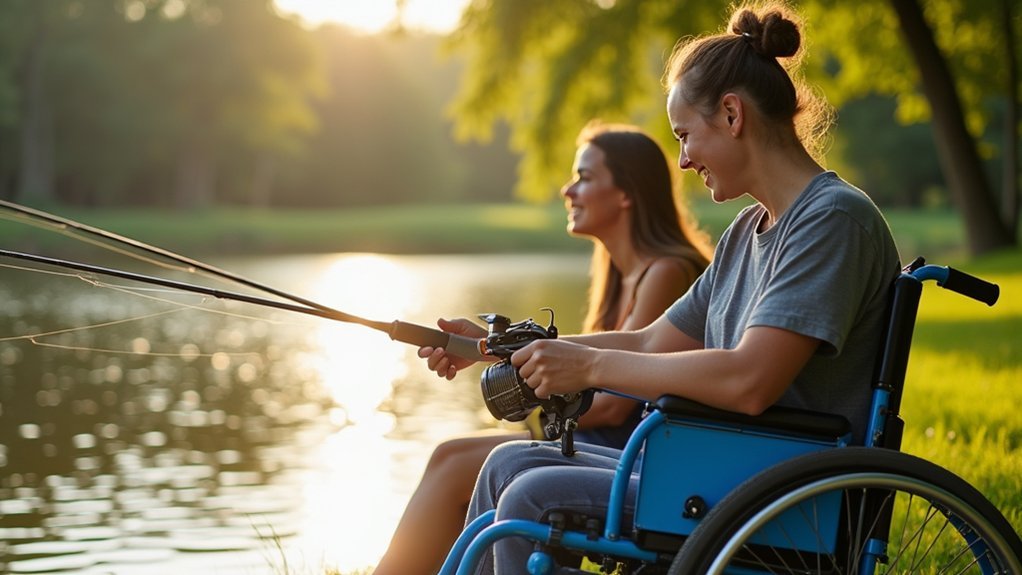
The transformative power of voice-controlled fishing reels has revolutionized lives across the country, creating pathways to independence that many disabled anglers never thought possible.
Take Hunter Baughman, a double amputee who now competes professionally using adaptive technology that lets him control his equipment without assistance.
Adaptive fishing technology empowers amputees like Hunter Baughman to compete professionally without assistance, transforming limitations into opportunities.
You’ll find these stories echoed throughout the disabled angling community. With voice commands replacing manual dexterity, anglers experience restored self-esteem and renewed mental health.
They’re rejoining family fishing trips, competing in tournaments like Major League Fishing, and developing fulfilling routines centered around the water.
Beyond the practical benefits, these technologies foster social inclusion as disabled anglers demonstrate their capabilities, challenging stereotypes and inspiring others.
The ripple effects extend far beyond fishing—they’re rebuilding confidence and independence in every aspect of life.
Hunter’s determination to be viewed as a serious competitor stems from his drive to win, not just enjoy fishing, as he focuses on ability, not disability when approaching competitions.
Technical Specifications: How Voice-Controlled Reels Actually Work
Voice-controlled fishing reels function through a sophisticated integration of speech recognition technology and precision mechanics. The system activates via your spoken commands, triggering the battery-powered motor that drives the gear system at ratios typically between 7:1 and 8:1.
These smart reels incorporate feedback mechanisms that confirm your commands through auditory or visual cues. You’ll find the technology remarkably user-friendly, with intelligent braking systems ensuring casting accuracy even hands-free. Originally designed for individuals with limited arm use, these reels have evolved to exceed performance expectations for disabled anglers.
The lightweight aluminum or carbon fiber construction doesn’t compromise on strength while maintaining portability. Most models feature water-resistant designs to protect the electronic components during wet conditions.
The motors are optimized for power efficiency, ensuring your battery lasts throughout your fishing expedition. These technological advancements make fishing accessible regardless of physical limitations.
Comparing Traditional vs. Voice-Activated Fishing Equipment

Comparing traditional fishing reels with their voice-activated counterparts reveals fundamental differences in accessibility, functionality, and user experience. While conventional reels require manual dexterity and physical strength, voice-controlled options offer hands-free operation that’s transformative for those with mobility limitations. Similar to how Shimano’s DC technology monitors spool speed to prevent backlashes, voice-activated equipment uses advanced technology to overcome physical barriers.
| Feature | Traditional Reels | Voice-Activated Reels |
|---|---|---|
| Operation | Manual effort required | Hands-free voice commands |
| Accessibility | Limited for disabled users | Highly accessible |
| Customization | Basic mechanical adjustments | Programmable for conditions |
| Learning Curve | Steeper, requires practice | Reduced, technology assists |
You’ll find voice-activated systems cost more initially, but they deliver exceptional value through increased independence and participation. They don’t just replace traditional equipment—they expand fishing possibilities for individuals who’d otherwise be excluded from this rewarding outdoor activity.
The Psychological Benefits of Autonomous Outdoor Activities
You’ll build genuine self-confidence as you master voice-controlled fishing reels and overcome challenges in your angling journey.
The autonomy these devices provide allows you to experience fishing success on your own terms, validating your capabilities and boosting your self-esteem.
Nature’s therapeutic presence during these independent outdoor pursuits creates a healing environment that reduces stress and promotes emotional well-being. Regular fishing excursions can help regulate your sympathetic nervous system in just minutes, creating an immediate sense of calm and restoration.
Building Self-Confidence
Autonomy stands at the core of psychological well-being for individuals with disabilities engaging in outdoor activities. When you master voice-controlled fishing reels, you’re not just catching fish—you’re building a powerful sense of competence that extends beyond the lakeside.
Each successful cast reinforces your belief in your capabilities rather than focusing on limitations. You’ll notice a transformation as you rely less on caregivers and more on your own problem-solving skills. The technology removes barriers that once caused anxiety and frustration, allowing you to experience the pride of achievement.
This newfound mastery fosters a positive identity where your narrative shifts from limitation to capability. The confidence gained through autonomous fishing creates ripple effects, strengthening your resilience and empowering you to tackle new challenges in all areas of life. These experiences contribute significantly to personal growth and achievement as you discover new abilities and possibilities.
Nature’s Healing Effect
Immersion in natural settings delivers powerful psychological benefits that extend far beyond the thrill of a successful catch. When you spend time outdoors fishing, you’re actually engaging in natural therapy—98% of studies confirm improved mental health outcomes from nature exposure.
You’ll experience reduced stress hormones and blood pressure while your cognitive functions sharpen. Memory, attention span, and overall mood improve as you escape urban noise and pollution. The peaceful environment of lakes, rivers, and oceans actively decreases nervous system arousal, promoting a sense of calm and relaxation. Both green and blue spaces offer these restorative benefits, with water environments potentially providing even greater psychological advantages.
For those with disabilities, autonomous outdoor activities like voice-controlled fishing create a powerful pathway to well-being. The combination of nature’s healing properties with independent recreation creates an experience that reduces feelings of isolation while enhancing emotional stability and self-esteem.
Accessibility Features Beyond Voice Control
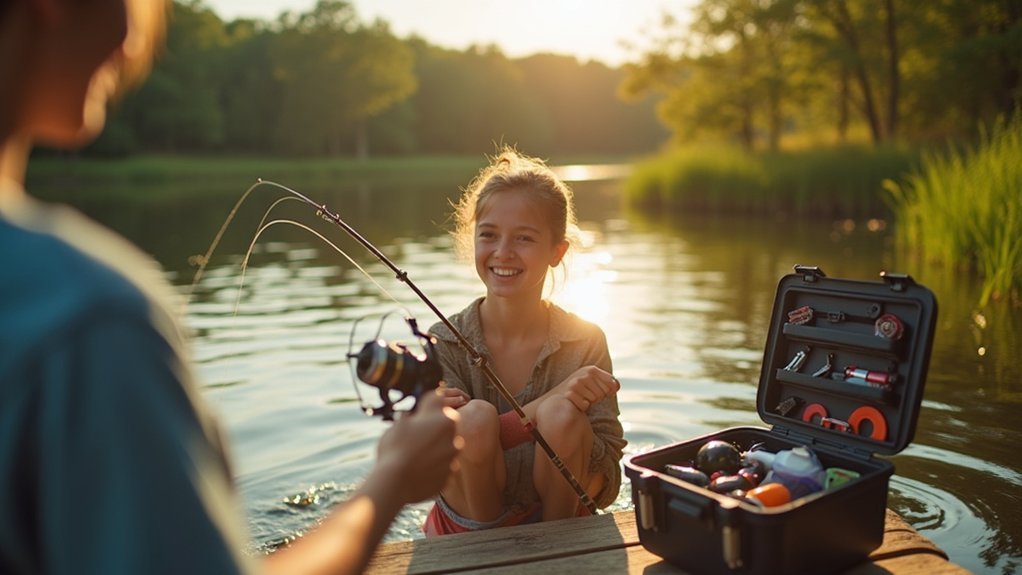
While voice control represents a significant advancement for anglers with disabilities, fishing accessibility extends far beyond verbal commands alone.
You’ll find electric reels that reduce physical effort and adaptive mounts that secure rods to wheelchairs, boats, or your body for stability without constant holding.
For those with limited grip strength, specialized handle extensions and lever handles provide better control, while fighting rod belts distribute weight around your waist to reduce arm fatigue. Many manufacturers offer powerful options like the 12V motor FreedomFISHR that completely replaces the need for manual cranking.
If you have sensory impairments, you can utilize audible bite indicators or visual cues like colored flags and lights to detect fish activity.
Don’t overlook knot tying aids that minimize the need for fine motor skills or stabilizing straps that enable secure rod handling with limited hand function.
Creating Community Through Adaptive Fishing Experiences
Adaptive fishing events create powerful bonds that extend far beyond the shoreline, transforming individual experiences into collective journeys of empowerment.
When you participate, you’ll find yourself among people of all ages—from four to 76—who share similar challenges and triumphs.
You’re not alone in your journey. These gatherings unite diverse participants with conditions like spinal cord injuries, cerebral palsy, and spina bifida, fostering meaningful connections across generations.
Connected through challenge, we find strength in each other—different bodies, shared spirits, one community.
Many participants rediscover activities they thought were forever lost, bringing renewed purpose and joy.
The collaborative efforts of non-profits, healthcare providers, and outdoor enthusiasts create spaces where your mental health flourishes alongside new friendships.
As you cast your line into the water, you’re also weaving yourself into a supportive community that understands your unique experiences.
The inaugural event at Lake Bentonville attracted over 75 participants, demonstrating the significant demand for accessible outdoor activities.
Cost Analysis and Financial Assistance for Adaptive Equipment
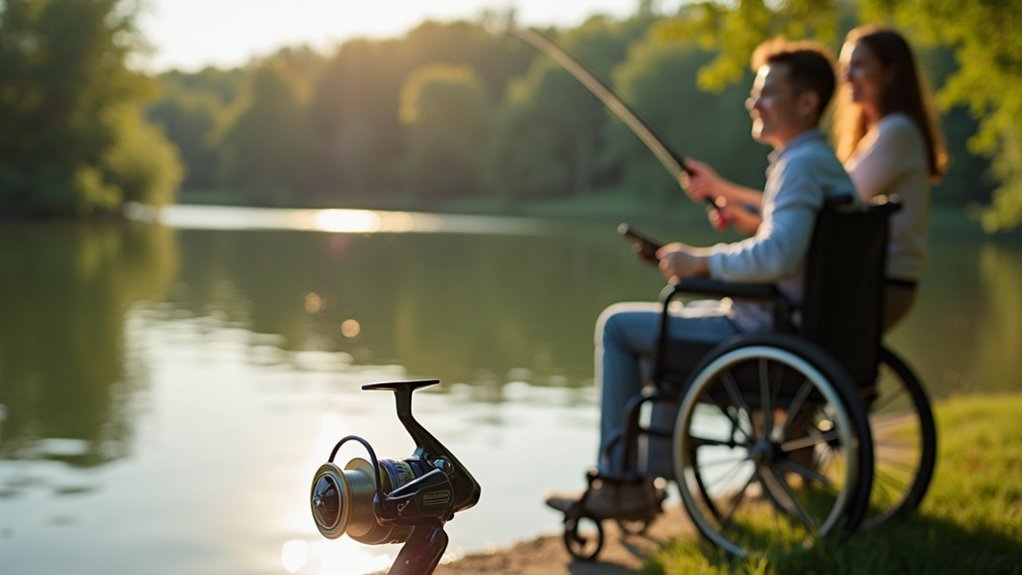
The price tag of specialized fishing equipment often presents a significant hurdle for anglers with disabilities.
Voice-controlled reels, while transformative, typically cost more than traditional equipment due to their advanced technology and customization requirements. Regular maintenance adds to the long-term investment.
Fortunately, several financial assistance programs can help offset these costs:
- IM ABLE Grants – Provides funding specifically for adaptive sports equipment and training
- Model System Hospitals – Offers resources and financial support for adaptive equipment needs
- Move United – A nonprofit that supports access to adaptive sports equipment
When applying for assistance, you’ll need to provide documentation of your disability and may face income requirements. For veterans who can’t find suitable grants, our layaway program offers flexible payment options for purchasing essential adaptive fishing equipment.
Despite these challenges, financial support makes these life-changing technologies accessible to more anglers with disabilities.
Weather Resilience: Using Voice Commands in Various Conditions
Weather presents one of the greatest challenges for anglers using voice-controlled technology on the water. While current fishing reels don’t yet offer voice control features, future developments will need to address these environmental obstacles.
You’ll need equipment that can withstand rain, as moisture threatens electronic components. Advanced systems might incorporate technology similar to the Shimano SLX DC reels, which use digital microprocessors to monitor performance in challenging conditions. Though today’s smart reels like the KastKing iReel One IFC meet IPX6 waterproofing standards, voice recognition systems will require additional protection against water interference.
Wind creates particular challenges for voice commands, potentially disrupting the technology’s ability to accurately interpret your instructions. Temperature variations and humidity can also affect performance, while ice and snow present unique obstacles in winter conditions.
For disabled anglers, these weather-resistant features aren’t just conveniences—they’re essential for maintaining independence on the water regardless of conditions.
Training and Learning Curve for Voice-Controlled Fishing Systems
Mastering voice-controlled fishing reels requires a unique learning journey that combines traditional fishing knowledge with cutting-edge technology skills. While these systems add a digital interface layer, they potentially simplify the physical demands that conventional baitcasters present. Like Shimano’s SLX DC reels, these voice systems monitor and adjust to prevent backlashes automatically, providing accessibility benefits.
Voice-controlled reels merge angling tradition with technology innovation, simplifying physical aspects while adding digital complexity.
You’ll progress faster by:
- Practicing voice commands in controlled environments before hitting the water
- Leveraging manufacturer tutorials and online community support
- Gradually integrating voice controls with traditional fishing techniques
Unlike spinning reels’ straightforward operation, voice-controlled systems demand familiarity with proper command phrasing and timing.
You’ll need to simultaneously manage voice inputs while monitoring environmental feedback like strikes and line tension. Though initially challenging, consistent practice bridges the gap between conventional tactile control and modern voice-activated fishing technology.
Future Innovations: What’s Next for Adaptive Fishing Technology
You’ll soon see AI-assisted casting systems that can predict ideal trajectory based on your target location and weather conditions.
Brain-computer interface controls are in development, allowing you to operate fishing equipment through thought alone, eliminating the need for voice commands or manual operation.
Self-adjusting equipment will automatically adapt tension, depth, and resistance based on real-time fish behavior data, making fishing more accessible and successful for anglers of all ability levels.
These innovations will leverage underwater cameras to provide critical visual feedback about fish movement patterns and habitat conditions, further enhancing the effectiveness of adaptive fishing systems for disabled anglers.
AI-Assisted Casting Systems
The frontiers of adaptive fishing technology are expanding with AI-assisted casting systems.
You’ll soon benefit from smart reels that analyze your technique in real time and suggest improvements tailored to your abilities. The FISH WINCH™ 4000 represents this evolution, offering one-handed operation and automatic line retrieval that makes fishing accessible to those with mobility challenges. Several electric variable-speed fishing reels are already available as part of adaptive fishing kits and bundles.
Three transformative AI casting innovations:
- Real-time location analysis identifies prime fishing spots by evaluating environmental conditions.
- Adaptive gear customization automatically adjusts to your physical abilities and preferences.
- Predictive modeling anticipates fish behavior patterns to optimize your casting strategy.
These technologies don’t just make fishing possible—they make it successful, allowing anglers with disabilities to experience independence and achievement on the water.
Brain-Computer Interface Controls
Looking beyond AI-assisted casting systems, brain-computer interface (BCI) controls represent the next frontier in adaptive fishing technology.
You’ll soon control your fishing reel with thought alone through non-invasive EEG systems that read brain signals.
Modern BCIs have evolved dramatically, requiring less training and offering faster response times than early models.
Imagine adjusting your reel’s tension or initiating a cast simply by focusing your thoughts.
When integrated with wearable devices like Greentek’s EEG caps, these systems could revolutionize mobility for anglers with disabilities.
Though currently expensive, ongoing research promises more affordable and customizable options.
Similar to how Cas King’s IAL 2 reel includes a beginner mode to reduce backlash, future BCI systems will offer simplified control settings for new users.
The therapeutic benefits extend beyond fishing itself—you’ll gain independence, enhanced social experiences, and improved well-being.
BCI technology will transform adaptive fishing from science fiction into accessible reality.
Self-Adjusting Equipment
Self-adjusting equipment stands at the forefront of adaptive fishing technology, with innovations that respond automatically to changing fishing conditions without manual intervention.
You’ll soon see reels that adjust tension based on fish size and behavior, eliminating the need for manual adjustments that can be challenging for disabled anglers.
These smart systems will transform your fishing experience through:
- Real-time monitoring sensors that detect water conditions and fish movements, automatically optimizing your gear’s performance
- Precision adjustment technology that modifies line tension and reel speed to improve catch rates while reducing physical strain
- Integration with wearables like smartwatches, providing tactile or audio feedback for visually impaired anglers
Advanced systems will soon incorporate data analytics for tailored fishing strategies, similar to how modern aquaculture operations optimize feeding processes.
Future tackle will incorporate energy-efficient designs and feedback loops that continuously adapt to environmental changes, making fishing more accessible and enjoyable.
Frequently Asked Questions
Can Voice-Controlled Reels Be Used Alongside Other Adaptive Fishing Equipment?
Yes, you’ll find voice-controlled reels integrate perfectly with adaptive equipment like rod holders, one-handed systems, motorized reels, arm braces, and customized rods, enhancing your fishing experience regardless of mobility challenges.
Are There Multilingual Options for Voice-Controlled Fishing Reels?
Yes, you’ll find many voice-controlled reels support multiple languages through integration with virtual assistants like Google Assistant or Alexa. You can select your preferred language and customize dialect settings for ideal recognition accuracy.
How Do Voice-Controlled Reels Perform During Competitive Fishing Tournaments?
You’ll find voice-controlled reels excel in tournaments by allowing hands-free operation, reducing fatigue, and enabling quick setting adjustments. They give you consistent casting performance while you focus on strategy rather than equipment manipulation.
Can Friends or Caregivers Program Custom Voice Commands?
Yes, you’ll find that friends or caregivers can program custom voice commands with proper training. Most systems allow for personalization, though technical expertise varies depending on the device’s interface and programming requirements.
What Backup Systems Exist if Voice Recognition Fails?
If voice recognition fails, you’ve got multiple backup options: manual switches (pushbutton, bite, blow, or foot-activated), Bluetooth app controls, physical rod holders, and automatic braking systems. You’ll also find battery backups for power concerns.
In Summary
You’ve seen how voice-controlled fishing reels aren’t just gadgets—they’re life-changing tools. They’re opening waters that were once off-limits and restoring independence to anglers with disabilities. As this technology evolves and becomes more affordable, you’ll witness even more barriers fall. Whether you’re disabled yourself or know someone who is, these innovations are transforming the fishing experience for everyone.

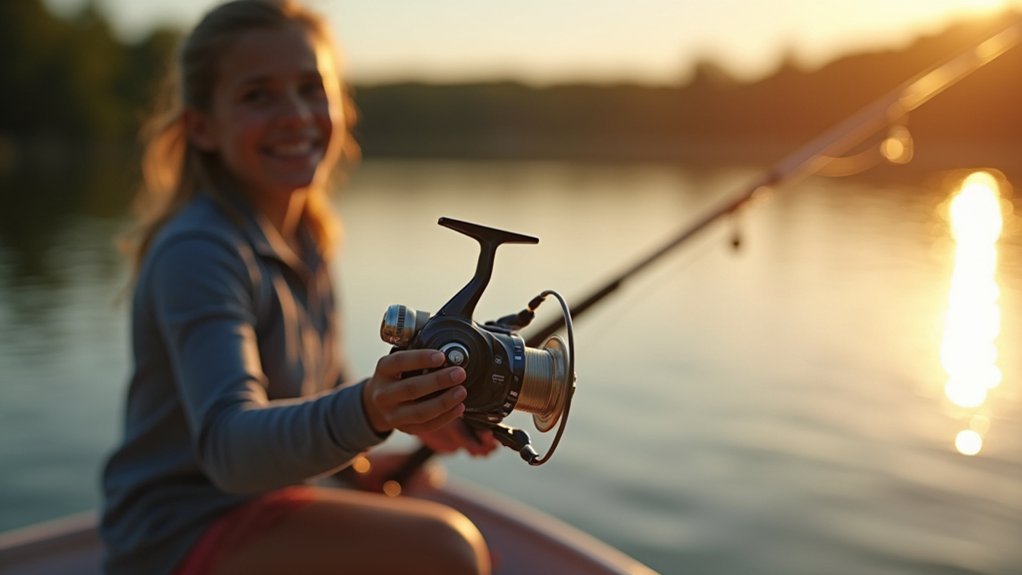



Leave a Reply